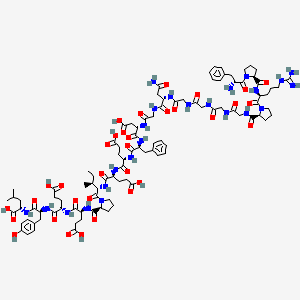

1. Angiomax
2. Angiomax Rtu
3. Bg 8967
4. Bg-8967
5. Bg8967
6. Bivalirudin Trifluoroacetate
7. Ctb-001
8. Hirulog
9. Hirulog-1
10. L-leucine, D-phenylalanyl-l-prolyl-l-arginyl-l-prolylglycylglycylglycylglycyl-l-asparaginylglycyl-l-alpha-aspartyl-l-phenylalanyl-l-alpha-glutamyl-l-alpha-glutamyl-l-isoleucyl-l-prolyl-l-alpha-glutamyl-l-alpha-glutamyl-l-tyrosyl-
11. Phe-pro-arg-pro-(gly)4 Desulfato-tyr63'-hirugen
12. Phe-pro-arg-pro-(gly)4-asn-gly-asp-phe-glu-glu-ile-pro-glu-glu-tyr-leu
13. Phe-pro-arg-pro-(gly)4-desulfohirudin-(53-64)
1. 128270-60-0
2. Angiomax
3. Bivalirudin Trifluoroacetate
4. Bg-8967
5. Bg8967
6. Hirulog
7. Chebi:59173
8. Hirulog-1
9. D-phenylalanyl-l-prolyl-l-arginyl-l-prolylglycylglycylglycylglycyl-l-asparaginylglycyl-l-alpha-aspartyl-l-phenylalanyl-l-alpha-glutamyl-l-alpha-glutamyl-l-isoleucyl-l-prolyl-l-alpha-glutamyl-l-alpha-glutamyl-l-tyrosyl-l-leucine
10. L-leucine, D-phenylalanyl-l-prolyl-l-arginyl-l-prolylglycylglycylglycylglycyl-l-asparaginylglycyl-l-alpha-aspartyl-l-phenylalanyl-l-alpha-glutamyl-l-alpha-glutamyl-l-isoleucyl-l-prolyl-l-alpha-glutamyl-l-alpha-glutamyl-l-tyrosyl-
11. Angiox
12. Bivalirudina
13. Bivalirudine
14. Bivalirudinum
15. Bg 8967
16. Unii-tn9bex005g
17. Bivalirudin [usan:inn:ban]
18. Bivalirudin Tfa
19. 1191386-55-6
20. Hs-2004
21. Tn9bex005g
22. Schembl25739
23. Gtpl6470
24. Bivalirudin Trifluoroacetate Salt
25. Chembl2103749
26. Dtxsid00155847
27. Bivalirudin;0.9% Sodium Chloride
28. Ex-a5843
29. Bdbm50248103
30. Mfcd08692016
31. Akos015994644
32. Db00006
33. 70b600
34. 270b600
35. J-005587
36. Q4919218
37. Bivalirudin Trifluoroacetate (h-dl-phe-dl-pro-dl-arg-dl-pro-gly-gly-gly-gly-dl-asn-gly-dl-asp-dl-phe-dl-glu-dl-glu-xiile-dl-pro-dl-glu-dl-glu-dl-tyr-dl-leu-oh.tfa)
| Molecular Weight | 2180.3 g/mol |
|---|---|
| Molecular Formula | C98H138N24O33 |
| XLogP3 | -7.1 |
| Hydrogen Bond Donor Count | 28 |
| Hydrogen Bond Acceptor Count | 35 |
| Rotatable Bond Count | 67 |
| Exact Mass | 2179.9891678 g/mol |
| Monoisotopic Mass | 2178.9858129 g/mol |
| Topological Polar Surface Area | 902 Ų |
| Heavy Atom Count | 155 |
| Formal Charge | 0 |
| Complexity | 4950 |
| Isotope Atom Count | 0 |
| Defined Atom Stereocenter Count | 16 |
| Undefined Atom Stereocenter Count | 0 |
| Defined Bond Stereocenter Count | 0 |
| Undefined Bond Stereocenter Count | 0 |
| Covalently Bonded Unit Count | 1 |
| 1 of 3 | |
|---|---|
| Drug Name | ANGIOMAX |
| Active Ingredient | BIVALIRUDIN |
| Company | THE MEDICINES CO (Application Number: N020873. Patents: 7582727, 7582727*PED, 7598343, 7598343*PED) |
| 2 of 3 | |
|---|---|
| Drug Name | BIVALIRUDIN IN 0.9% SODIUM CHLORIDE |
| Active Ingredient | BIVALIRUDIN |
| Company | BAXTER HLTHCARE CORP (Application Number: N208374) |
| 3 of 3 | |
|---|---|
| Drug Name | BIVALIRUDIN |
| Active Ingredient | BIVALIRUDIN |
| Company | ACCORD HLTHCARE (Application Number: A206551); APOTEX INC (Application Number: A204876); DR REDDYS LABS LTD (Application Number: A201577); FRESENIUS KABI USA (Application Number: A090189); HOSPIRA INC (Application Number: A090811); HOSPIRA INC (Application Number: A090816) |
For treatment of heparin-induced thrombocytopenia and for the prevention of thrombosis. Bivalirudin is indicated for use in patients undergoing percutaneous coronary intervention (PCI), in patients at moderate to high risk acute coronary syndromes due to unstable angina or non-ST segment elevation in whom a PCI is planned.
FDA Label
Angiox is indicated as an anticoagulant in adult patients undergoing percutaneous coronary intervention (PCI), including patients with ST-segment-elevation myocardial infarction (STEMI) undergoing primary PCI.
Angiox is also indicated for the treatment of adult patients with unstable angina / non-ST-segment-elevation myocardial infarction (UA / NSTEMI) planned for urgent or early intervention.
Angiox should be administered with aspirin and clopidogrel.
Bivalirudin mediates an inhibitory action on thrombin by directly and specifically binding to both the catalytic site and anion-binding exosite of circulating and clot-bound thrombin. The action of bivalirudin is reversible because thrombin will slowly cleave the thrombin-bivalirudin bond which recovers the active site of thrombin.
Antithrombins
Endogenous factors and drugs that directly inhibit the action of THROMBIN, usually by blocking its enzymatic activity. They are distinguished from INDIRECT THROMBIN INHIBITORS, such as HEPARIN, which act by enhancing the inhibitory effects of antithrombins. (See all compounds classified as Antithrombins.)
B01AE06
B - Blood and blood forming organs
B01 - Antithrombotic agents
B01A - Antithrombotic agents
B01AE - Direct thrombin inhibitors
B01AE06 - Bivalirudin
Absorption
Following intravenous administration, bivalirudin exhibits linear pharmacokinetics. The mean steady state concentration is 12.3 +/- 1.7mcg/mL after administration of an intravenous bolus of 1mg/kg followd by a 2.5mg/kg/hr intravenous infusion given over 4 hours.
Route of Elimination
Bivalirudin is cleared from plasma by a combination of renal mechanisms (20%) and proteolytic cleavage.
Volume of Distribution
0.2L/kg
Clearance
3.4 mL/min/kg [Normal renal function]
3.4 mL/min/kg [mild renal function]
2.7 mL/min/kg [moderate renal function]
2.8 mL/min/kg [severe renal function]
1 mL/min/kg [Dialysis-dependent patients]
80% proteolytic cleavage
Normal renal function: 25 min (in normal conditions)
Creatinine clearance 10-29mL/min: 57min
Dialysis-dependant patients: 3.5h
Inhibits the action of thrombin by binding both to its catalytic site and to its anion-binding exosite. Thrombin is a serine proteinase that plays a central role in the thrombotic process, acting to cleave fibrinogen into fibrin monomers and to activate Factor XIII to Factor XIIIa, allowing fibrin to develop a covalently cross-linked framework which stabilizes the thrombus; thrombin also activates Factors V and VIII, promoting further thrombin generation, and activates platelets, stimulating aggregation and granule release.
BUILDING BLOCK

MARKET PLACE

